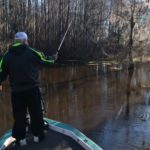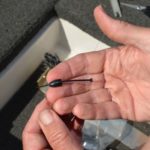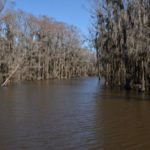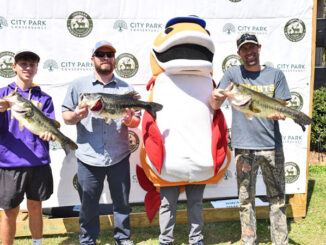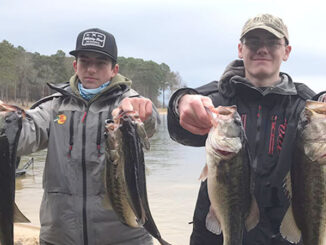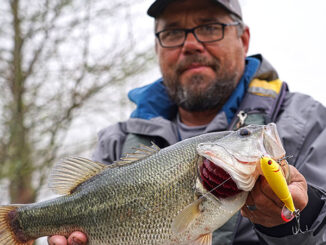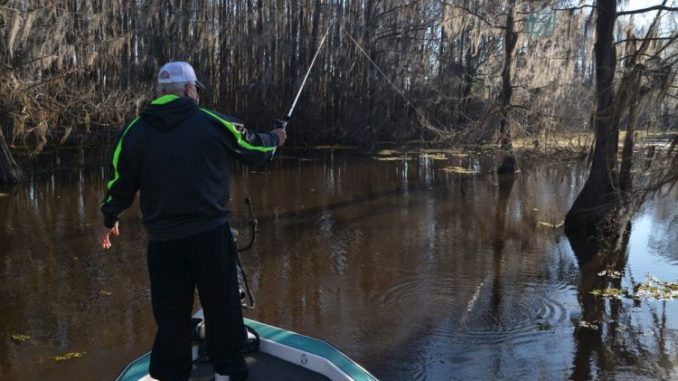
Lake Bistineau in Northwest Louisiana is home to some lunker bass, and unfortunately, lots of salvinia, too. Here’s how one local angler fishes the first half of the year — and deals with the weedy pest.
“We fished this very spot,” murmured 59-year-old Rickey Lee. “I can’t remember names and faces, but I can remember where I caught a fish.”
Pointing to a cypress tree, he added, “That’s where I caught my first 5-pound bass. It was on a black and yellow H & H spinner. I was about 11. He said, ‘I knew you had it in you.’”
The “he” Lee was referring to was Derwood Jordan, an adult neighbor who took him bass fishing in Lake Bistineau. Lee’s father fished for white perch (crappie) and catfish with yo-yos. But he didn’t bass fish.
“He (Jordan) had an aluminum jon boat with a 5 ½ horsepower Johnson on it. I ran the motor and he paddled us to fish. His knowledge of the lake was incredible.
“When I started fishing with him, I kept my baits in a matchbox; a black and yellow H & H, a Cotton Cordell Red Fin and some worms.
“Back then, we kept everything. Now I don’t keep a bass. When I want to eat fish, I get my white perch pole.”
He has been a serious tournament fisherman for 30 years, now fishing two major circuits with partner Jeremy Botica, the BOSS Tournament Trail and the H&W Marine Team Trail, plus multiple local benefit tournaments.
But his love has always been Lake Bistineau, and his name is almost synonymous with fishing and hunting the lake.
It was no sweat launching Lee’s boat that morning. He put in right next to his house perched on Bistineau’s shoreline. From there, he ran to the north end of the elongated reservoir.
This end of the lake had a lot of submerged stumps and literally zillions of cypress trees — none of them real big, but plenty of them. He moved from the narrow channel to pick his way through what he called “sloughs” and “flats.”
They didn’t look much different; both had cypress trees in and on them. But the sloughs were 7 to 8 feet deep, while the flats held only 2 to 3 feet of water.
“Lake maps, electronic or paper, are helpful in locating sloughs,” he coached. “Some even give the names of the sloughs.” Some of the more prominent sloughs carry signs tacked to trees, as well.
“Another thing that is useful is to be on the lake during its annual drawdown. The last 10 or 12 years the Department of Wildlife and Fisheries has drawn down the lake 7 feet for salvinia control.
“There will be water in the lower lake, but the upper end will be dry except for 1 to 2 feet in the sloughs.” During low water, the locations of the sloughs are simple to learn.
This day, Lee was hunting for spawning fish. According to him, bass begin spawning on the flats in Bistineau in late February or early March. Most spawning is over by April first. His pattern of pitching creature baits on the shallow flats holds through the spawn.
A one-trick pony
Rickey Lee fished the entire day with a single lure, a Mr. Twister Flip’n Out. The creature bait is his favorite during the spawn.
“I’ve almost become a one-trick pony, but I’ve become very good at that trick,” he grinned contentedly. The pros say ‘fish your strength.’ That’s what Jeremy (Jeremy Botica, his regular fishing partner) and I do.”
Lee noted that he will also occasionally uses 4-inch Reaction Innovations Sweet Beavers.
Favorite colors include variations of black and red, black and blue or watermelon. “Okeechobee Craw, a metal flake blue color, is a particularly good color in this lake,” he noted.
“The clearer the water, the lighter color I will use. In dingy water I use dark baits.”
He pegs the bullet weight used with the lure with a rubber nail-like Peg-It Sinker Peg. After snubbing the head of the peg to the weight, he clips off and discards the loose tail, then slides the weight down the line to the hook.
Since the peg holds the weight in position, it allows him to move the weight up the line to fish his lure Carolina rig style.
Lee will also work in the use of a lizard, rigged weightless on a 4/0 hook, when he sees a fish on its spawning bed. He either tosses it directly onto the bed or floats it in with gentle movements. “They will attack it to remove it from their bed,” he explained.
Casting, flipping, or pitching
Lee fishes in dense stands of trees with lots of overhead branches that interfere with typical overhand casts. Plus, long casts are seldom necessary. Lee worms his boat through the very trees that are the targets of his casts.
“I never cast overhand,” he rumbled in a low voice. “For the most part, all we do is flip. The fish in this lake really relate to trees. This gets it under the limbs of the cypresses and presents the lure quietly.
“The pros really call this ‘pitching.’ When you yo-yo the line with your free hand, it’s flipping.” What Lee is really doing is precision underhand casting.
“When I was a kid, I thought it would be neat to learn this. My momma gave me a coffee can and I went into the back yard with it. After a month or so, I got to where I could hit the can most of the time.
“The hardest thing is to get the motion down.”
This is not finesse fishing. He cast the lure, let it sink, moved it 1, 2 or 3 inches, and then swiftly retrieved it. Most fish hit it immediately, on its way to the bottom.
“You don’t have to beg fish here to bite,” he grinned.
Bistineau’s best conditions
The early March day began with a dominating cold mist, but gave way to blue skies swept by a brisk breeze carrying strong hints of spring.
“This is really a perfect Bistineau day,” Lee said. “For some reason, Bistineau is best on a clear, windy day. Because of all the trees, you are setting still, not bouncing on waves. It’s protected and you can fish.
“Another good thing is that the wind moves salvinia around, clearing spots you can fish.
“Some people say that they want a cloudy day for bass fishing. On Caddo Lake, cloudy, rainy days are best, even though the lake has a lot of trees.
“It might be because they are different trees. Caddo has bald cypress with big bases. Most people around here call these red cypresses.”
Patterning the bass
The number of trees makes the number of choices for targets overwhelming, but Lee cautioned not to let the number of trees hide the pattern during the spawn that occurs on all lakes.
“Smaller males are in the shallowest waters preparing and guarding nests. Bigger pre-spawn females hold up on the edges of 8- to 10-foot deep sloughs.”
He chuckled audibly as he worked the boat down a slough when I asked him how he chose target trees. “I throw at everyone in reach.
“One thing you quickly learn is that every tree has two sides. If the fish is on one side and I throw my bait to the other side, he can’t see it.
“When Jeremy is fishing with me, he and I stand on the bow together. He hits one side of the tree; I hit the other.”
Patterning Rickey Lee
Bass fishing in Lake Bistineau is a January to July thing for Rickey Lee. Fishing during the pre-spawn and the spawn is done with creature baits.
Post-spawn, from April to mid-summer, he still uses some creature baits, but shifts mostly to Southpaw Custom jigs in “black and something else” colors like blue, amber, brown or red, and to Mr. Twister worms.
Worms are typically 10 to 12 inches long, although smaller 6- to 8-inch worms are also used. All are Texas-rigged.
He admitted that there are some fishing opportunities for crankbaits and Carolina rigs in open water, especially in the lower lake, but it’s not something that he and his acquaintances do.
“Salvinia has been the big game-changer. It will foul up spinners and crank baits immediately.”
By depth, he fishes 5 to 6 feet deep on the edges of flats during the pre-spawn, 2- to 4-foot depths up on the flats during the spawn, 4- to 5-foot depths on the edges during the post-spawn, and when the water gets into the 80s, he will fish 7 to 10 feet deep. “That’s deep for Bistineau,” he posited.
Like other local anglers, Lee breaks the lake into 3 sections. The upper section is from Bayou Dorcheat (which was dammed to make the lake) down to Port O’ Bistineau boat launch.
The middle section is from Port O’ Bistineau to the Gregg Lake area. The lower lake is from Gregg Lake to the dam.
The further north, the thicker are the stands of trees. “There are trees in every spot, but it gets progressively more open as you go south.
“I don’t change a thing when I fish the other parts of the lake. There’s just less trees to throw at.”
The Louisiana Department of Wildlife and Fisheries draws lake water levels down dramatically beginning sometime between July 4 and Labor Day — and Lee quits bass fishing.
“That’s when I start white perch fishing the lake. I’m really getting after them in August and September.”
In September, he teal hunts on the lake every day of the season, followed by duck hunting it from the season opening to Christmas.
“There are some people who fish for bass all winter on the lake and they catch some good fish, but I feel that if you don’t take a break from something, you burn out.”
